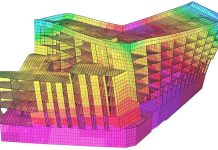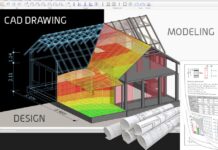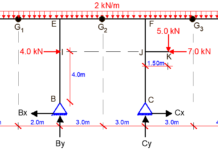It is desired to find the eigenfrequencies and eigenvectors (modal parameters) of concrete water tank support when filled with water. This is a case of undamped free vibration, treating the stored water as a lumped mass on the tank stand. The tank will be treated as a system with 2 degrees of freedom, considering lateral displacement only.
Data and Load Analysis;
Density of concrete = 24 KN/m3
Thickness of slab = 150mm
Dimension of columns = 230 x 230mm
Supporting beams = 300 x 230mm
Weight of water = 10 KN/m3
Size of tank = 2000 litres
Modulus of elasticity of concrete = 21.7 × 106 KN/m2
Load Analysis
Self weight of slab = 24 KN/m3 × 0.15m × 2.5m × 2.5m = 22.5 KN = 2293.75 kg
Weight of supporting beams on the four sides = 4 × 24 KN/m3 × 2.27m × 0.23m × 0.3m = 15.036 KN = 1532.77kg
Weight of water = 10 KN/m3 × 2m3 = 20 KN = 2038.73 kg
Weight of tank (assume) = 75kg
At the 1st level = 2293.75 + 1532.77 + 2038.73 + 75 = 5940.25 kg
At the 2nd level = 2293.75 + 1532.77 + 2(2038.73) + 2(75) = 8053.98 kg
We are assuming that the floor slab is very stiff compared to the columns. So the flexural rigidity is taken as infinity.
Geometrical properties of the sections
Columns = 23cm x 23cm = 0.23m x 0.23m
Moment of inertia of column IC = (0.23 × 0.233)/12 = 2.332 × 10-4 m4
EIC = (2.332 × 10-4 m4) × (2.1 × 107 KN/m2) = 4897.2 KN.m2
The mass matrix of the structure is given below;
(12EIC)/L3 = (12 × 4897.2)/33 = 2176.533 KN/m
K11 = (12EIC)/h3 + (12EIC)/h3
K11 = 2176.533 + 2176.533 = 4353.067
K21 = -(2176.533 + 2176.533) = -4353.067
K22 = 2(2176.533) + 2(2176.533) = 8706.132
The stiffness matrix is therefore;
For an undamped free vibration, the equation of motion is;
Mü + ku = 0 —————– (1)
Arranging this in matrix form, we obtain;
On solving;
((4353.067 × 103 – 5940.25ω2) × (8706.132 × 103 – 8053.98ω2) – (4353.067 × 103 × 4353.067 × 103) = 0
On simplifying;
(4.783 × 107)ω4 – (8.677 × 1010)ω2 + (1.8949 × 1013) = 0
On solving;
ω12 = 253.9146 rad2/sec2
ω22 = 1559.9 rad2/sec2
ω1 = 15.9347 rad/sec
ω2 = 39.4951 rad/sec
The natural frequencies;
F1 = ω1/2π = 2.5361 Hz
F2 = ω2/2π = 6.2858 Hz
Determination of the mode shapes
For ω12 = 253.9146 rad2/sec2
Considering the first row of the matrix;
(2.8448 × 106)A1 – (4353.067 × 103)A2 = 0
Setting A1 = 1.0
A2 = (2.8448 × 106)/(4353.067 × 103) = 0.6780
Therefore;ϕ1 = [1, 0.6535]T
For ω22 = 1559.9 rad2/sec2
Considering the first row of the matrix;
(-4.9129 × 106)A1 – (4353.067 × 103)A2 = 0
Setting A1 = 1.0
A2 = (-4.9129 × 106)/(4353.067 × 103) = -1.128
Therefore;ϕ2 = [1, -1.128]T
As a verification;
K1/M1 = 2381668.751 / 9379.8 = ω12 = 253.9146 rad2/sec2
K2/M2 = 25251112,921 / 9379.8 = ω22 = 1559.9 rad2/sec2
Eigenvector Mass Orthonormalization
The idea is to obtain;
ϕ1T Mϕ1 = 1.0
The conversion factor;
Therefore, C1 = 1/√(9379.8) = 0.0103
Hence;
Similarly;
Therefore, C2 = 1/√(16188.005) = 0.00785
Hence;
We can therefore obtain;
Let χi(t) be the generalised coordinate which represent the amplitude of the orthonormalised mode shape.
The displacement time history response is therefore; u(t) = Φχ(t)
But the modal equation of motion
Mü + ku = 0 —————– (1)
Realise that;
Substituting ü and u into equation 1 and multiplying by ΦT , we obtain;
ΦT MΦẍ + ΦT KΦx = 0
Which finally leads to;
ẍ + Kgx = 0
This leads to the following differential equations;
ẍ1(t) + 253.9146x1(t) = 0 ——————– (a)
ẍ2(t) + 1559.9x2(t) = 0 ——————– (b)
Let the initial condition be a unit velocity;
x1(0) = 0; ẋ1(0) = 0
Solving the differential equation by Laplace Transform;
For mode 1;
ẍ1(t) + 253.9146x1(t) = 0 x1(0) = 0; ẋ1(0) = 1.0
(s2x ̅ – sx0 – x1) + 253.9146x ̅ = 0
s2x ̅ – 1 + 253.9146x ̅ = 0
x ̅ (s2 + 253.9146) = 1
x ̅ = 1 / (s2 + 253.9146)
On solving by Laplace Transform;
x1 = (1/√253.9146) sin(√253.9146)
x1 = 0.0627 sin(15.935t)
For mode 2;
ẍ2(t) + 1559.96x2(t) = 0 x1(0) = 0; ẋ1(0) = 1.0
(s2x ̅ – sx0 – x1) + 1559.9x ̅ = 0
s2x ̅ – 1 + 1559.9x ̅ = 0
x ̅ (s2 + 1559.9) = 1
x ̅ = 1 / (s2 + 1559.9)
On solving by Laplace Transform;
x2 = (1/√1559.9) sin(√1559.9)
x2 = 0.0253 sin(39.495t)
Knowing that
u(t) = Φχ(t)
The displacement time history is therefore;
u1(t) = 0.00064581 sin(15.935t) + 0.0001986 sin(39.495t)
u2(t) = 0.0004219 sin(15.935t) – 0.000224 sin(39.495t)
The displacement time history graph is shown below;











Hello Bro,
I think there are a few typo's in your post, specifically Load Analysis.
What would you consider to be your effective span of slab and beam?
Beam DIm (230mm x 300mm)
Wouldn't your effective span be 3 metres ?
Fc
Thank you for the observation. I used a former picture and the correction has been effected.
This may be a trivial question, I am assuming that the tanks are some how connected to the slabs hence the inclusion of the mass?
what would be the dynamic effect if only in contact with slab due to gravity and you introducing a vibration?
Fc
Good post as usual
FC
Could you let us download this file. Thanks.
•It’s in reality a great and useful piece of information. I am happy that you simply shared this helpful info with us. Please keep us informed like this. Thank you for sharing.Fabrication Drawings preparation in UK
MEP F modelling in UK
Interference Analysis in UK
COBie adaptation in UK
Thanks for sharing the post.. parents are worlds best person in each lives of individual..they need or must succeed to sustain needs of the family. learn more
Thanks for sharing this information. your blog is good and I got so much knowledge…